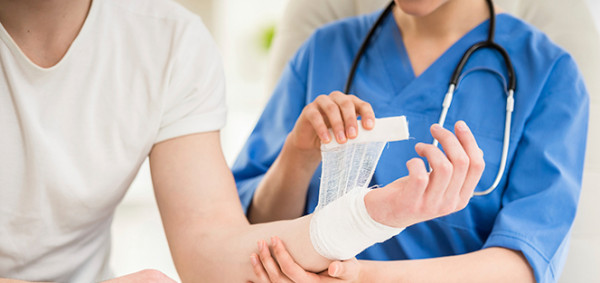Wound Center
St. Mary's Wound and Hyperbaric Center provides proven wound-healing therapies, faster healing times and better healing rates. We utilize sophisticated wound-care protocols and advanced clinical approaches, including hyperbaric oxygen therapy, that are proven to reduce healing time, improve healing rates and prevent possible limb loss. In fact, patients who have suffered from chronic wounds for months, even years, are routinely restored to health in a shorter time than they ever thought possible.
 Comprehensive Wound Care
Comprehensive Wound Care
Complex and non-healing wounds often require the advanced care provided by the St. Mary's Wound and Hyperbaric Center. We are a specialized outpatient wound care treatment center dedicated to the care of patients with chronic, non-healing wounds.
The Wound Center Advantage
Patients referred to our program benefit from a comprehensive approach to wound care. Our center is staffed by a multidisciplinary team of physicians, nurses and technicians with advanced training in wound care and hyperbaric medicine. Integrating a team of wound care professionals increases the level of care, while offering patients the most advanced healing options.
For patients, that means faster healing times, longer-lasting results, decreased amputation rates and increased mobility.
Treatment for All Types of Wounds
We treat all wounds, but specialize in those that are acute or chronic and especially those difficult to heal.
Examples include:
- Arterial insufficiency ulcers
- Burns
- Compromised skin grafts and flaps
- Crush injuries
- Diabetic foot ulcers
- Late effects of radiation
- Neuropathic wounds
- Osteomyelitis
- Osteoradionecrosis
- Pressure ulcers
- Progressive necrotizing infections
- Surgical wounds
- Traumatic peripheral ischemia
- Venous ulcers
Advanced Modalities, Evidence-Based Therapies and Technologies
Our state-of-the-art center utilizes therapies and techniques that are proven to reduce healing time, improve healing rates and prevent possible loss of limb. Our advanced treatments include:
- Hyperbaric oxygen therapy (HBO)
- Negative pressure therapy
- Bioengineered tissue alternatives
- Total contact casting and offloading devices
- Advanced dressings and compression wraps
- Aggressive debridement protocols
- Antibiotic therapies
Hyperbaric Oxygen Therapy (HBO)
Hyperbaric oxygen (HBO) therapy is a treatment in which you breathe 100 percent pure oxygen while inside a pressurized chamber. The air pressure inside a hyperbaric oxygen chamber is about two and a half times greater than the normal pressure in the atmosphere.
This “hyperbaric” (or high pressure) dose of oxygen helps your blood carry more oxygen to organs and connective tissues to promote wound healing. HBO also activates the white blood cells to fight infection. It can be the primary treatment or it can be used in combination with other treatments.
HBO therapy is an outpatient procedure that is provided once daily, for approximately four to six weeks. One treatment takes around two hours and is quite comfortable for most patients.
Diabetic Foot Ulcers (DFU)
Approximately 25-30% of patients with diabetes develop a foot sore, or ulcer. Though foot ulcers can be anywhere on the foot, most occur on the ball of the foot or on the bottom of the big toe. There are several reasons why diabetics have foot problems, but the most common reason is that many diabetics suffer from nerve damage called neuropathy, which causes loss of sensation in the feet. Additionally, diabetics also suffer from poor circulation, which can make your foot less able to fight infection and heal. Poor circulation can also change the shape of your feet or toes, which also causes problems.
Other factors that contribute to the risk of developing foot problems include:
- Elevated blood sugars
- Obesity
- Alcoholism
- Hypothyroidism
- Hypertension
- Smoking
Once you develop an ulcer, it may take weeks or even several months for it to heal. Foot ulcers are the most common reason for hospital stays for people with diabetes. Left untreated, a foot ulcer can become infected and in turn lead to the loss of a limb. In fact, research has shown that diabetic foot ulcers precede approximately 84 percent of all lower leg amputations.
Diabetic ulcers are often painless, so special care must be given to taking care of your feet.
Free Foot Screenings
Free screenings include an exam, health education and giveaways for people with foot-related concerns or those having difficulty caring for their own feet. Screenings will be provided by registered nurses from 9 to 11 a.m. every Wednesday
Venous Leg Ulcers (VLU)
Venous leg ulcers are one of the most common types of wounds occurring in the lower limb, developing mostly along the inside of the lower leg, below the knee. A venous ulcer occurs when swelling, due to damaged valves of the lower leg veins, is uncontrolled. This can cause blood to pool in the ankles and fluid to leak into the surrounding tissue. This fluid breaks down the tissue and an ulcer forms. Venous ulcers can be quite painful.
Numerous disorders can contribute to the damage of your veins, including deep vein thrombosis, phlebitis, congestive heart failure, obesity, multiple pregnancies and muscle weakness secondary to paralysis or arthritis.
Any two of the following will increase your risk of developing a venous ulcer:
- Obesity
- Immobility
- Over 60 years old
- Varicose veins
- History of phlebitis or deep vein thrombosis (DVT)
- Malnutrition
Once you develop an ulcer, they are generally slow to heal and often come back if you don’t take steps to prevent them.
The St. Mary's Wound and Hyperbaric Center is located within St. Mary’s Medical Center at 2900 First Avenue, Huntington. For more information, or to make an appointment, call 304.399.7450.
